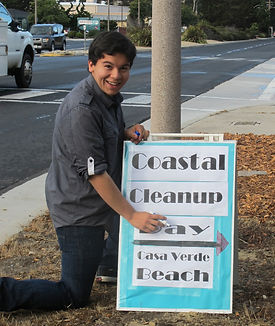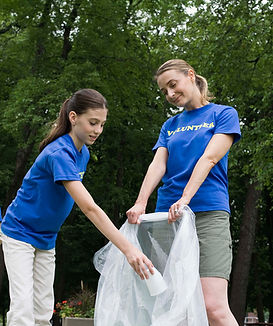
Links to Tritia's scholarly presentations and papers related to Service Learning and
Civic Engagement in Adolescents:
(all copyright Tritia Moneypenny)

Service Learning
How do we connect young people to their communities in meaningful, intentional ways?
How might we help youth build competency and character while solving social issues?
What opportunities positively influence teenagers' social empathy and civic engagement well into adulthood?
Service Learning is the answer!
Service can be voluntary, mandated, or organized through a school. It can also have varying degrees of impact on youth and the community. Service learning is curriculum-based service organized through a course (or institution) that meets academic and community needs. It often includes reflection components (Kielsmeier, Scales, Roehlkepartain, & Neal, 2004; Davidson, Jimenez, Onifade, & Hankins, 2010). Ideally, the service would challenge systems of power and privilege that created the need in the first place.
Benefits of Service Learning
For Volunteers
Many positive outcomes exist for individuals who particiapte in service activities:
-
positive identity formation,
-
sense of purpose,
-
academic knowledge and skills,
-
civic skills,
-
diversity awareness, and
-
stereotype reductions,
-
among many others.
For Recipients
Beyond having their needs met, recipients of service can feel more connected to their community. But, whenever possible, Butin (2003) recommends that the recipients determine ways in which they wish to be helped. This keeps the recipient's dignity intact while allowing those serving to meaningfully assist. Efforts within service learning programs should not reinforce paradigms of privilege and power over the underprivileged or silenced (Butin, 2003, pp. 1678-1679).
For the Larger Community
Some benefits include vibrancy of marginalized groups; strengthened community connections and networks; and policy changes supporting underprivileged groups. Flanagan and Van Horn (2003) state that communities are more able to see youth as assets and not liabilities (p. 287).
Facilitating Effective Service Learning
Quality service learning experiences are key to improving communities.
Build Empathy First
They should include opportunities to increase an understanding of and empathy for the social issue. McGuire and Gamble (2006) assert that students who care about the social issue report greater increases in community belonging and social responsibility (p. 296). Youniss and Yates (1999) suggest that service should connect to the history of the organization (as cited in Flanagan & Van Horn, 2003, p. 288). This way students view their contributions as adding to a rich history of efforts.
Develop Skills
Opportunities should build cooperation, communication, leadership, and time management skills.
Support Endeavors
Butin (2003) suggests service learning be sponsored at the department or institution level. This way experiences can be longer than one course, cross many content areas, and become part of the institution’s commitment to the community. Additionally, Kielsmeier et al. (2004) advocate for stronger funding and infrastructure supporting teachers who incorporate service learning as integral components of their curriculum.
Extended Service Length is Best
The length, depth, and duration of service learning experiences influence realized outcomes. Butin (2003) argues that “students need multiple opportunities to engage with the ambiguity and complexity of the experience” (p. 1677). This allows students to “form a sustained connection to their communities” (Flanagan & Van Horn, 2003, p. 288). Building these relationships can increase the social connectivity of all participants—students, educators, recipients, and community. It can also increase their critical consciousness and civic responsibility (Whitley, 2014, p. 23).
Yet, McGuire and Gamble (2006) report that the level of emotional engagement in the service project predicted increases in social responsibility or community belonging.
Reflection is Key
There is no arguing that reflection is a critically important component of effective service learning (Butin, 2003; Davidson et al., 2010; Lakin & Mahoney, 2006; Niemi et al., 2000; Whitley, 2014).
-
What have participants learned about themselves?
-
What have they noticed in the recipients of service?
-
How are the various participants similar, different?
-
How does the greater society, culture, or community contribute to the recipients needing services?
-
How does society respond to them, or help meet their needs?
-
How can the social system be changed such to alleviate the need for assistance to exist?
-
How can you create that change?
Additional Resources
References
Butin, D. W. (2003). Of what use is it? Multiple conceptualizations of service learning within education. Teachers College Record, 105(9), 1674-1692.
Davidson, W. S., Jimenez, T. R., Onifade, E., & Hankins, S. S. (2010). Student experiences of the Adolescent Diversion Project: A community-based exemplar in the pedagogy of servicelearning. American Journal of Community Psychology, 46(3-4), 442-458. doi: 10.1007/s10464-010-9337-6
Flanagan, C., & Van Horn, C. (2003). Youth civic development: A logical next step in community youth development. In F. A. Villarruel, D. F. Perkins, L. M. Borden, & J. G. Keith (eds.), Community youth development: Programs, policies, and practices (pp. 273-296). Thousand Oaks, CA: Sage Publications, Inc.
Kielsmeier, J. C., Scales, P. C., Roehlkepartain, E. C., & Neal, M. (2004). Community service and service-learning in public schools. Reclaiming Children and Youth, 13(3), 138-143.
Lakin, R., & Mahoney, A. (2006). Empowering youth to change their world: Identifying key components of a community service program to promote positive development. Journal of School Psychology, 44(6), 513-531.
McGuire, J. K., & Gamble, W. C. (2006). Community service for youth: The value of psychological engagement over number of hours spent. Journal of Adolescence, 29(xx), 289-298.
Niemi, R. G., Hepburn., M. A., & Chapman, C. (2000). Community service by high school students: A cure for civic ills? Political Behavior, 22(1), 45-69.
Whitley, M. A. (2014). A draft conceptual framework of relevant theories to inform future rigorous research on student service-learning outcomes. Michigan Journal of Community Service Learning, 20(2), 19+. Retrieved from http://go.galegroup.com/ps/i.do?id=GALE%7CA386612859&v=2.1&u=ksu&it=r&p=AONE&sw=w&asid=37e663d1f3dc916ca4b8af69524fcf0d